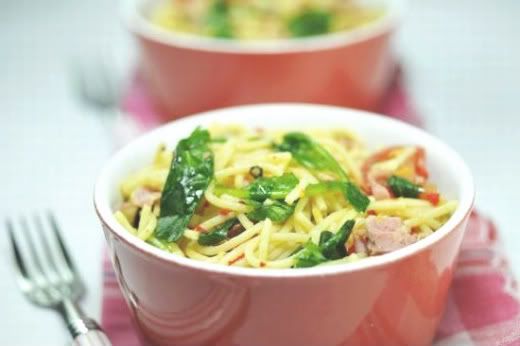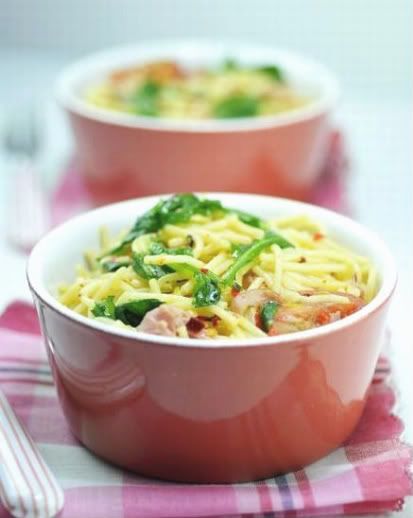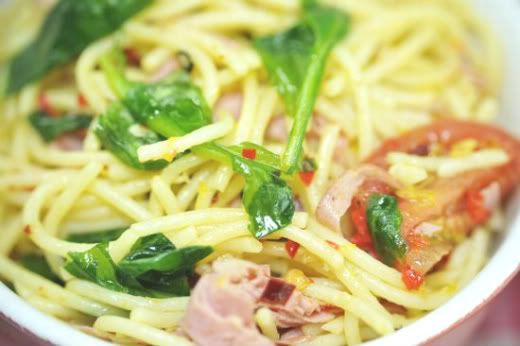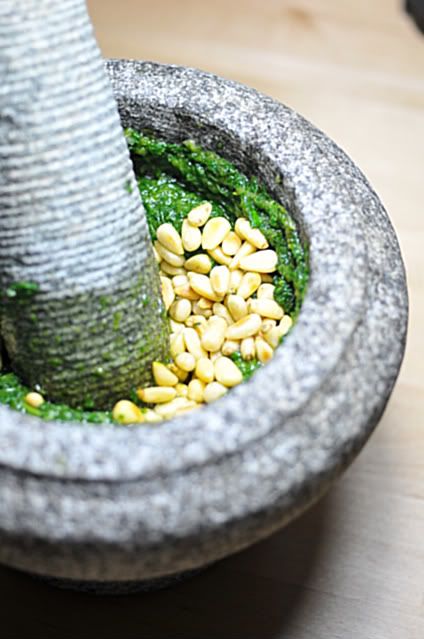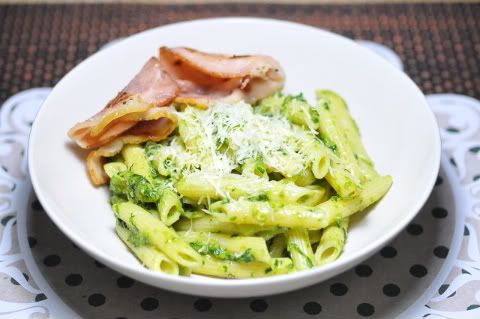This month’s March 2009 challenge is hosted by Mary of
Beans and Caviar, Melinda of
Melbourne Larder and Enza of
Io Da Grande. They have chosen Lasagna of Emilia-Romagna from Lynne Rossetto Kasper's
The Splendid Table as the challenge.
When I read the details, I was particular excited as it reminded me of the time when we were asked to make pizza from scratch, including tossing the pizza dough. In this month’s challenge, we were required to hand make our own spinach pasta and this happens to be the main criteria. This is one task which I certainly would not have attempted from scratch especially when there is easily available pasta in the supermarkets, both fresh and dried. This particular the lasagna has to be accompanied with a béchamel (white) and ragu sauce, either using the recipes provided by our hosts or using our own favourites. Lynne had also kindly included instructions on how to roll the pasta for those of us who do not own a pasta machine … me being one of them! At first I thought of running out and buying a pasta machine but after weighing the pros/cons, decided against it. Hmmm how many times would I be using it any way! Nah .... certainly not worth spending the money!
I used the spinach pasta and béchamel sauce recipes provided but substituted the ragu sauce with my own version. I think the rolling of the pasta was the most difficult of all. I tried to get it as thin as possible and this took some bicep strength. I also didn’t use all the flour that was required for the pasta and omitted about ½ cup out. The dough was already quite dry by then. I think (and I’m not an expert at this) this could be due to the type of flour used and room temperature conditions. When it came to assembling, I followed my own version of layering, plus adding mozzarella in addition to parmesan for the lasagna. However I must have been a bit too over generous with layering the béchamel, ragu sauce and cheese, and these somewhat overwhelmed the spinach pasta. Next time, I’m be way less generous! Overall this is an excellent recipe and the lasagna was delicious. The spinach pasta was very delicate and I found that it’s as good as any found in an Italian restaurant. Many thanks to our March hosts for coming up with another challenging experience and another acquired skill for me.
 Lasagna of Emilia-Romagna (Lasagna Verdi al Forno)
Lasagna of Emilia-Romagna (Lasagna Verdi al Forno)
(Serves 8 to 10 as a first course, 6to 8 as a main dish)10 quarts (9 litres) salted water
1 recipe Spinach Pasta cut for lasagna (recipe below)
1 recipe Béchamel Sauce (recipe below)
1 recipe Meat Ragu (recipe below)
1 cup freshly grated Parmigiano-Reggiano (parmesan)
2 cups grated mozzarella
Working Ahead:The ragu and the béchamel sauce can be made up to three days ahead. The ragu can also be frozen for up to one month. The pasta can be rolled out, cut and dried up to 24 hours before cooking. The assembled lasagna can wait at room temperature (20 degrees Celsius/68 degrees Fahrenheit) about 1 hour before baking. Do not refrigerate it before baking, as the topping of béchamel and cheese will overcook by the time the center is hot.
Assembling the Ingredients:Have all the sauces, rewarmed gently over a medium heat, and the pasta at hand. Have a large perforated skimmer and a large bowl of cold water next to the stove. Spread a double thickness of paper towels over a large counter space.
Cooking the Pasta:Bring the salted water to a boil. Drop about four pieces of pasta in the water at a time. Cook about 2 minutes. If you are using dried pasta, cook about 4 minutes, taste, and cook longer if necessary. The pasta will continue cooking during baking, so make sure it is only barely tender. Lift the lasagna from the water with a skimmer, drain, and then slip into the bowl of cold water to stop cooking. When cool, lift out and dry on the paper towels. Repeat until all the pasta is cooked.
Assembling the Lasagna:Spread a thin layer of béchamel over the bottom of the baking dish. Arrange a layer of about four overlapping sheets of pasta over the béchamel. Spread a thin layer ragu sauce on top of the sheets. After that sprinkle about 3 or 4 spoonfuls of béchamel sauce. You do not need to spread the béchamel sauce as it will spread out whilst cooking. Then top with 1/3 of the mozzarella. Repeat the layers until all ingredients are used, finishing with béchamel sauce and mozzarella and your final topping would be a generous dusting of parmesan. (I used only half my ingredients and assembled it into a 3-layer lasagna, using a 10” x 10” square pan. I saved the rest for the day after.)

 Baking and Serving the Lasagna:
Baking and Serving the Lasagna:Preheat the oven to 200C. Cover the baking dish lightly with foil, taking care not to let it touch the top of the lasagna. Bake 40 minutes, or until almost heated through. Remove the foil and bake another 10 minutes, or until hot in the center (test by inserting a knife – if it comes out very warm, the dish is ready). Take care not to brown the cheese topping. It should be melted, creamy looking and barely tinged with a little gold. Turn off the oven, leave the door ajar and let the lasagna rest for about 10 minutes. Then serve. This is not a solid lasagna, but a moist one that slips a bit when it is cut and served.
Spinach Egg Pasta (Pasta Verde)
Preparation: 45 minutes
Makes enough for 6 to 8 first course servings or 4 to 6 main course servings, equivalent to 450g dried boxed pasta.2 jumbo eggs (60g or more)
300g fresh spinach, rinsed dry, and finely chopped; or 170g frozen chopped spinach, defrosted and squeezed dry
3 1/2 cups (400g) all purpose unbleached (plain) flour (organic stone ground preferred)
Working by Hand:
EquipmentA roomy work surface, 24 to 30 inches deep by 30 to 36 inches (60cm to 77cm deep by 60cm to 92cm). Any smooth surface will do, but marble cools dough slightly, making it less flexible than desired.
A pastry scraper and a small wooden spoon for blending the dough.
A wooden dowel-style rolling pin. In Italy, pasta makers use one about 35 inches long and 2 inches thick (89cm long and 5cm thick). The shorter American-style pin with handles at either end can be used, but the longer it is, the easier it is to roll the pasta.
Plastic wrap to wrap the resting dough and to cover rolled-out pasta waiting to be filled. It protects the pasta from drying out too quickly.
A sharp chef’s knife for cutting pasta sheets.
Cloth-covered chair backs, broom handles, or specially designed pasta racks found in cookware shops for draping the pasta. (I used the oven’s baking rack for this purpose)
 Mixing the dough:
Mixing the dough:Mound the flour in the center of your work surface and make a well in the middle. Add the eggs and spinach. Use a wooden spoon to beat together the eggs and spinach. Then gradually start incorporating shallow scrapings of flour from the sides of the well into the liquid. As you work more and more flour into the liquid, the well’s sides may collapse. Use a pastry scraper to keep the liquids from running off and to incorporate the last bits of flour into the dough. Don’t worry if it looks like a hopelessly rough and messy lump.
 Kneading:
Kneading:With the aid of the scraper to scoop up unruly pieces, start kneading the dough. Once it becomes a cohesive mass, use the scraper to remove any bits of hard flour on the work surface – these will make the dough lumpy. Knead the dough for about 3 minutes. Its consistency should be elastic and a little sticky. If it is too sticky to move easily, knead in a few more tablespoons of flour. Continue kneading about 10 minutes, or until the dough has become satiny, smooth, and very elastic. It will feel alive under your hands. Do not shortcut this step. Wrap the dough in plastic wrap, and let it relax at room temperature 30 minutes to 3 hours.

 Stretching and Thinning:
Stretching and Thinning:If using an extra-long rolling pin work with half the dough at a time. With a regular-length rolling pin, roll out a quarter of the dough at a time and keep the rest of the dough wrapped. Lightly sprinkle a large work surface with flour. The idea is to stretch the dough rather than press down and push it. Shape it into a ball and begin rolling out to form a circle, frequently turning the disc of dough a quarter turn. As it thins outs, start rolling the disc back on the pin a quarter of the way toward the center and stretching it gently sideways by running the palms of your hands over the rolled-up dough from the center of the pin outward. Unroll, turn the disc a quarter turn, and repeat. Do twice more.
Stretch and even out the center of the disc by rolling the dough a quarter of the way back on the pin. Then gently push the rolling pin away from you with one hand while holding the sheet in place on the work surface with the other hand. Repeat three more times, turning the dough a quarter turn each time.
Repeat the two processes as the disc becomes larger and thinner. The goal is a sheet of even thickness. For lasagna, the sheet should be so thin that you can clearly see your hand through it and see colours. Cut into rectangles about 4 by 8 inches (10 x 20 cm).
Dry the pasta at room temperature and store in a sealed container or bag.
Basic Ragu Sauce:
(serves 6 - 8 as main course)
Ingredients:200g of minced beef (or substitute with any other minced meat)
200g streaky bacon (sliced into strips)
300g mixed variety of sausages (Cumberland, bratwurst, Italian) casing removed and lightly mixed the meat together
1 medium size carrot, roughly diced
2 stalks of celery, roughly diced
1 large onion, roughly diced
3 cloves garlic, minced
3 Tbsp olive oil
2 x 400g can of stewed chopped tomatoes
4 Tbsp tomato paste
3/4 cup of canned or freshly prepared stock (beef, chicken or vegetable stock. Alternatively you could use either red/white wine or just water)
Kosher salt and coarsely ground black pepper to taste
1 Tbsp of dried Italian herbs to taste
2 dried bay leaves (or 3 fresh ones)
Method:1) Add oil to pan, and fry the bacon until lightly browned.
2) Add into the same pan, the diced onion and garlic, fry for about 1 minute. Then add in all the diced vegetables and cook for about 2 minutes.
3) Add the minced beef and sausages with the vegetables and fry for about 8 to 10 minutes, until the juices start to seep out. Then add in the canned tomatoes and bay leaves, and stir for about a minute or 2.
4) Then add in the stock and tomato paste. After that cook over low fire, simmering for about 10 minutes and then add in the salt, pepper and herbs to taste. Cover the pot and let it gently simmer for another 20 minutes, and taste. Add more seasoning if insufficient.
Béchamel Sauce
Preparation Time: 15 minutesIngredients:60g unsalted butter
4 Tbsp (60g) all purpose unbleached (plain) flour, organic stone ground preferred
2 and 2/3 cups (approx 570ml) milk
Salt and freshly ground pepper to taste
Freshly grated nutmeg to taste (I used store bought nutmeg powder)
Method:Using a medium-sized saucepan, melt the butter over low to medium heat. Sift in the flour, whisk until smooth, and then stir (without stopping) for about 3 minutes. Whisk in the milk a little at a time and keep the mixture smooth. Bring to a slow simmer, and stir 3 to 4 minutes, or until the sauce thickens. Cook, stirring, for about 5 minutes, until the sauce thickens. Season with salt, pepper, and a hint of nutmeg. Once cooked, take off stove. Cut a piece of cling wrap film and cover the top of the sauce to prevent it from form forming a skin.






